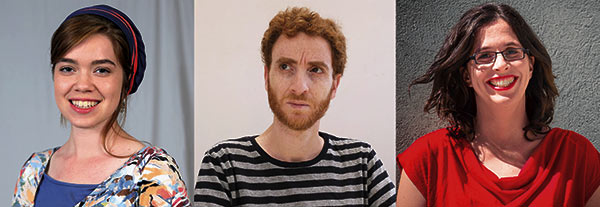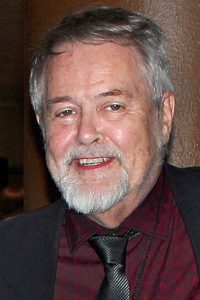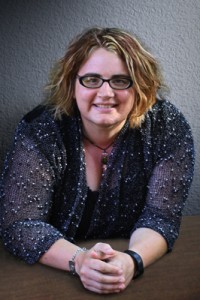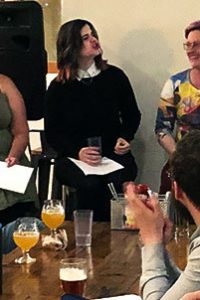SF in Israel: The Elephant Slowly Disappearing from the Room, by Ehud Maimon

The last two decades have been a very good time for genre writing in Israel. We see more and more writers and more and more works – from Weird Fiction to hardcore SF and everything in between. One thing, however, is obviously missing, at least for me as a reader and an editor: the Jewish heritage. The Bible (the Old Testament), the Talmud and other Rabbinical sources, all the way to 18th- and 19th-century Hassidic stories – all these could be adapted and drawn on in the same way that genre writing around the world draws from local (and foreign) traditions. So why are they so rarely used in Israeli SF/F writing?
The reasons as I see them have a lot to do with Israeli society and history. One of the oldest and deepest divides in Israeli society today is between religious and secular Israelis. To understand the scarcity of Jewish sources in Israeli SF/F, we have to look at both sides of this divide.
In the period leading up to the foundation of Israel, and in the first decades of the country’s existence, religion was actively rejected by the most influential stream in Zionism. This stream was a product of 19th-century European nationalism and many of the most influential people in it were socialists. To them, their past symbolized the diaspora and diasporic existence of a weak and persecuted minority, and their great project was to (re)create Jewish presence and a Jewish state in Palestine. For that, they would create The New Jew – the farmer-warrior, young and vibrant, who learned only the historical aspects of the Bible to reconnect to the Land of the Ancestors, while disregarding the religious aspects. This was an antithesis of the old Jewish ideal – the learned man who devotes his life to the study of the Torah and Talmud and other sacred texts.
With this new ideal came the rejection of centuries’ worth of cultural heritage. After the foundation of Israel, a “melting pot” ideology and policy were put into practice, and Jews from all over the world were educated in a system dedicated to nation-building, which devoted scant attention to the Jewish culture in the diaspora. A child growing up in the Israeli school system was taught some Bible chapters and a little about the cultural heritage that followed, but not a lot of it. This is not to say that all that heritage was lost – it lives on in many homes – but for secular Israeli children the knowledge and resources of this culture are not readily available.
Political and social changes in Israel over the last few decades have in a way compounded the problem. After decades of feeling, and to some extent being, marginalized, the large religious population in Israel has recently gained more political power. Some of the most prominent new religious politicians are extreme in their demand to give Judaism a more significant place in Israeli society and institutions, and are using their influence to try and get their way. This has led to a backlash among secular Israelis, who feel their way of life is threatened. Many have responded by branding traditional texts as alien and menacing, and rejecting them.
The near absence of Jewish sources in the writing of secular SF/F writers has as much to do with what they find familiar as with what they deem foreign. Many of the writers working today in Israel grew up reading SF/F, and when they started writing it was their natural medium. Drawing on SF/F materials they knew and loved, they produced works within those literary traditions, such as YA novels about young people coming into their magical powers, adventures in space, epic and urban fantasy, and near-future SF.
To these common themes of SF/F, local secular writers add motifs of secular Israeli culture. One of my own favorite examples is Agam HaTzlalim (Lake of Shadows) by Roni Gelbfish. In this YA fantasy, the magical system is based on modern Hebrew poetry, combining the new Israeli culture with fantasy themes. The forces and abilities of the magical creatures in the book are connected to the Judaean Desert, the history of the city of Beit She’an going back to Roman times, and to the Sea of Galilee. Then there is Keren Landsman, who, in Lev HaMa’agal (The Heart of the Circle, published in English in 2019), has magicians manipulating the four Aristotelian elements in present-day Tel Aviv, and dealing with the problems facing Israeli society. Rotem Baruchin, in her Somrey Ha’Arim (City Guardians) stories, writes of entities which are partly physical manifestations of Israeli villages, towns, and cities, so for instance her Jerusalem in not only an infinitely complex city, but also a complex personality.
That is not to say that there are no secular writers that deal with Jewish themes and draw from these traditions. Asaf Asheri in his novel Simantov (due to be published in English early 2020) did extensive research and offers a view of Elijah that diverges from common traditions. And it is not surprising that one of the novels that most prominently portrays Jewish demonology, Shedim BeRchov Agripas (Demons on Agripas Street), was written by Hagay Dagan, a scholar of Jewish mythology.

On the other side of the divide we find writers and fans coming from Israel’s religious circles. Usually, they are much more familiar from childhood with Jewish traditions than most secular writers. And yet, among religious SF/F writers too, these elements are often missing.
Naturally, most of these writers are from the more liberal part of the religious spectrum. (It’s worth mentioning, though, that even among ultra-orthodox Jews there is some fantasy and even comics writing about King David and other figures, it’s strictly for children and strictly didactic by nature.) Unlike extremists, they are not averse to engaging with secular themes and culture. If they are indeed more versed in Jewish tradition why is it absent in their works?
There are a few factors that make religious writers reluctant to handle these materials. First and foremost is the simple fact that these are sacred texts, sacred traditions. If you grew up believing certain texts are sacred, you are not likely to pick them apart and use bits in secular literature. Moreover, in some societal circles, dabbling with religious texts can be taken to carry a penalty. A religious genre author told me that when she talked about the fact she’s dealing with Jewish demonology in her writing, one person asked, sincerely, if she’s not afraid for herself and her family.

Religious writers are also up against some ideas and ideals that are centuries old. There is the idea of “Bitul Torah.” The passage from the book of Joshua (1:8), “This book of the law shall not depart out of thy mouth; but thou shalt meditate therein day and night,” has long been taken to mean that all free time should be spent studying religious texts. This concept was so fundamental that in modern times, when non-religious studies started making inroads in Jewish society, they were met with outrage. To this day, even among some liberal Rabbis, this idea is entrenched – you’d do better to read a page from the Talmud than write a page of prose. It’s a social and mental hurdle that many a religious writer has to tackle.
Religious SF/F fans and writers also talk about a dissonance that is inherent to their lives as a whole. As religious people living in a mostly secular society, they experience a disconnect between the two worlds. So when authors start writing their own works, their inspiration and immediate associations come from the SF/F works they’ve read rather than from religious texts.
However, when these religious writers of SF/F do deal with Jewish materials, the result is often fascinating. We get stories like “Resisey Laila” (Night Dew Drops), in which Hadas Misgav offers a retelling of sorts of the Song of Songs. We have Judith Kagan basing her story “Ru’ach Kadim” (Eastern Wind) on the rebuilding of Jericho, mentioned in a single verse in 1 Kings, 16. Itai Shlamkovich writes a science fiction story, “Drone Shel Shabat” (Shabbos Drone), taking place in Israel after Ben David (that is, the Messiah) has come.
Other works suffused with Jewish motifs come from writers who were raised in religious homes but are no longer religious themselves. Just about anything Shimon Adaf writes is steeped in tradition, and works like Kfor (Nuntia) and Shadrach do wonders integrating elements of Jewish history and culture into futuristic worlds. Hagy Averbuch uses his religious background and knowledge to great effect in “Anakim” (Giants) – an alien encounter story evoking the “sons of God” (from Genesis, 6) and the law regarding the victim of an unknown assailant (Deuteronomy, 21). His “Me’achar Shenitna Reshut” (“Since Permission Was Granted”) can perhaps best be described as a Jewish Lovecraftian story based on a commentary by Rashi to a verse from the book of Exodus.
Israeli SF/F writers have some unique problems when it comes to dealing with materials taken from the Jewish tradition, when compared to Jewish writers in other parts of the world, because of the complicated place this tradition occupies in the history of Israel. It leads to an absence of these themes from Israeli SF/F which is a bit of “an elephant in the room” – a lacuna that hasn’t really been talked about. But it is beginning to change. People are beginning to talk about this, and write works based on these traditions, works that strive to adapt figures, themes, and literary structures.
My thanks to Judith Kagan for sharing her insights with me.
–Ehud Maimon
This story and more like it in the November 2019 issue of Locus.
 While you are here, please take a moment to support Locus with a one-time or recurring donation. We rely on reader donations to keep the magazine and site going, and would like to keep the site paywall free, but WE NEED YOUR FINANCIAL SUPPORT to continue quality coverage of the science fiction and fantasy field.
While you are here, please take a moment to support Locus with a one-time or recurring donation. We rely on reader donations to keep the magazine and site going, and would like to keep the site paywall free, but WE NEED YOUR FINANCIAL SUPPORT to continue quality coverage of the science fiction and fantasy field.







